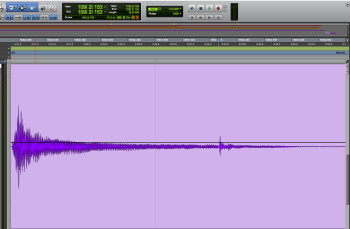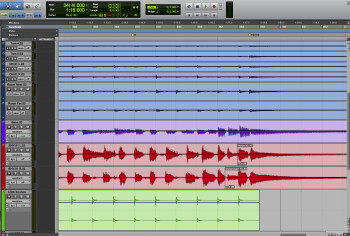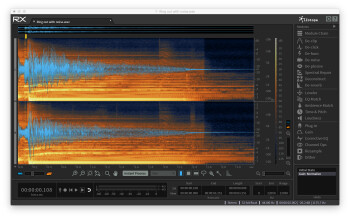When recording an ensemble or just overdubbing one instrument, there's one part of the song that gets very little attention: right after the very last chord or note has been struck. Especially if the last hit is a sustained one, a lot can go wrong while those notes are decaying.
It’s during that time that any track that’s being captured through a microphone is vulnerable to picking up unwanted noises. If the song has a dead-stop ending, the noise issue is much less of a problem

With a ring-out ending, you want to let the last note or chord die away naturally on all the instruments. You want to keep going until the instruments naturally decay out. As long as everything sustains cleanly for a few seconds, you should have enough to do an authentic sounding fadeout of those final notes in the mix. If somebody stops their note prematurely, however, there’s a possibility that it will be so noticeable that you’ll have to fade the other instruments out at the same point, and it could sound unnatural.
Tip jar
Here are some tips to help avoid the kinds of problems described above.
1. Be proactive. Remind the musicians before the take that they’re going to let the last note or chord ring out and sustain. Ask them to be as still as possible when that happens, and not to talk. Having them quietly hold their breath during the ring out is a good idea, as well, because breathing can be picked up by the mics in some cases. It’s a good idea to give them the “wait” hand signal as the note starts to ring out to remind them to hold it, and you can cue them when it’s ok to release.
2. Be careful of the click. One of the more insidious noises that can get on your track is click-track bleed from the headphones. Some musicians like to record with their headphones slightly off on one ear so they can hear themselves in the room better. However, if they’re doing that near an open mic, the click, which is typically a sharp sound with a hard transient, can often bleed into it. So what to do? If you’re just engineering and not playing an instrument yourself, you could mute the click as the musicians hit the last note or chord. Otherwise, you could program a custom click on a MIDI track that stops right before the last beat. Use a drum instrument, play or step-sequence four quarter notes to create one measure of click. Then quantize the measure and duplicate it up to that last hit.
Similarly, instrument sounds can also bleed from the cue mix. If you have musicians with one ear of their headphones all or partially off, it’s a good idea to record the musicians (or musician in the case of an overdub) playing the ending before they record an serious take, so you can check for bleed.

3. Beware of noisy furniture. Chair squeaks are often picked up by a mic during the ring out. Even if a player is trying to be still, a little weight shift can sometimes trigger a noise. The only way to prevent this is to make sure that the chairs you use for the musicians are not squeaky to begin with. Metal folding chairs tend to be quiet, and are inexpensive, so they might be the answer as a replacement for noisy wooden chairs.
4. Watch out for background noise. Because most of our home studios are in houses or apartments, not soundproofed studios, we’re at the mercy of what’s going on outside. A dog suddenly barking could get picked up, or a car honking or neighbor starting a lawn mower. There’s not a lot you can do about those kinds of random sounds (except do another take), but you can make sure that there’s no extraneous noise coming from inside your studio, such as fans or air conditioning.
5. Don’t get a buzz on: If you’re recording electric guitars via a miked amp, you face the possibility of buzz and hum from a high-gain guitar sound becoming audible during the ring out because the sound of the band is no longer there to cover it. If a guitarist uses a gate to prevent this, be careful that it doesn’t close in the middle of the sustaining end note, cutting it off prematurely. Repositioning the guitarist can sometimes alleviate some of the buzz. Also, ask the guitarist to avoid using a compressor, if possible, because compression can accentuate these kinds of noise issues. If it’s a hard-stop ending, the guitarist should immediately turn off his volume on the guitar or put his or her hands over the strings to silence them.
6. Make it a phone free zone. Imagine you’re recording a perfect take, you hit that last note, and as it rings out, somebody’s cell phone starts ringing. Yes, you could punch in the last hit, or record the ending over and then edit it in to replace the first, one, but better not to have to deal with it at all. All phones in the studio should be on silent, or better yet, turned of for the recording. Even the buzz of a silenced phone vibrating could get picked up during the ring out.
Noises off

Let’s say you discover when you go to mix that despite your best efforts, there are noises marring one or more of the tracks (sometimes they’re subtle and you don’t even know they’re there until you solo each track to check it when mixing). If it’s not too late, have the musicians re-take the last hit, if you can match the sounds. If not, and if the track is irreplaceable, you can try an audio restoration program such as iZotope RX, which has some pretty amazing features in it for removing stray noises, particularly in sustaining notes.
Fade away
The last impression is almost as important as the first. Paying careful attention to what happens at the very end will help ensure your songs are impactful throughout.
